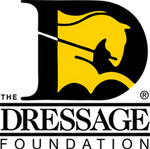
The 2021 Breeders Orientation Course
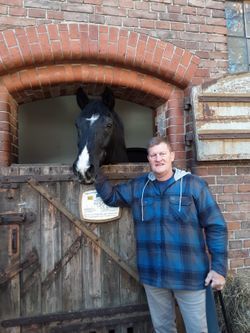
Rotspon and Tom
Hanoverian Breeders Course 2021
Thank you so much for the grant which enabled me to attend the Breeders Orientation Course held in Verden, Lower Saxony, Germany in November 2021. I was originally intending to go in 2020, but the Covid-19 pandemic caused a year’s delay. With my appetite whetted by the forced delay, I was even more determined to make the trip. It was everything I hoped for and so much more!
What I wanted to learn...
Firstly, I wanted to develop my ability to judge the conformation of a warmblood horse, using the criteria as set forth by the Verband. Using the weaknesses thus identified in my own mares, could I then choose stallions to improve upon those weaknesses? Secondly, I was anxious to see how the German farmers managed their herds; how they delivered hay, how the barns were set up, what grains they fed, how they separated by sex and age, and so forth. Could I adopt some of these practices to my own situation? Thirdly, what is the market like in Germany, and how does it compare to the USA? How do the auctions actually work?
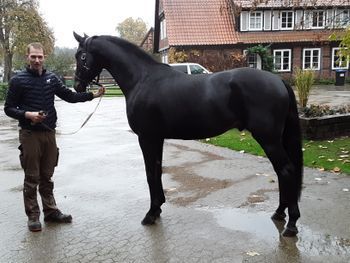
Stallion at Medingen
And what I learned...
Goal 1) How to correctly judge the conformation of a dressage horse using the Hanoverian criteria.
There are some rare individuals who can simply look at a stallion move and say, "He'd be great for your mare.” For them, it's an art. They somehow instinctively know what would work and what wouldn't. Spoiler alert: I am not one of those folks. For me to gain some tools to make breeding more of a science than art is invaluable.
The Verband is after a certain "type" of horse. There is no true Hanoverian breed; the studbook will accept many breeds and registries like Thoroughbreds, Oldenburgs, Arabs, Trakehners, and others if they conform to the Hanoverian "type.” The breeding goal is to produce "a noble, correctly built warmblood horse of superior performance; a horse with natural impulsion and space-gaining elastic movements- a horse that because of its temperament, character, and willingness is suited principally as an all-around riding horse.” While the last bit about temperament and character is perhaps subjective in nature (one person's 'wild horse' is another person's 'I like them spicy'), the first part about "correctly built" can be more readily judged by using a score sheet. The "Conformation Judgement" scoresheet is used by the Verband officials at horse inspections. On a scale of 1 to 10, body parts are evaluated, and a final summation score is assigned. After educating us on what to look for, we evaluated four mares. I was happy to see that my scores were usually quite close to those given by one of the worlds' foremost authorities on the warmblood horse, Dr. Ludwig Christmann.
In actual practice, the German Inspectors have an app on their cellphones. They simply insert the scores, press "go", and the inspection results are uploaded into the correct database in the correct format. Owners/breeders can see the results instantly. Plus, the numbers for the sire, damsire, and all other ancestors are immediately recalculated and updated as discussed in the following paragraphs.
Of course, once you know the relative strengths and deficiencies of your broodmare, the trick is choosing a stallion to correct the weaknesses while keeping favorable traits. To help in this regard, the Verband prints a Stallion Yearbook with breeding values. This book is hard to come by. I managed to beg and plead to the correct person working at the Verband, and they finally caved and gave me one. It basically consists of numbers and graphs corresponding to each stallion's inspection scores and those of his offspring. Also taken into consideration are his performance scores, show results, results of his offspring and down through generations - pretty much anything that can be evaluated about him, and his get is assigned a number. The result is a bar graph for each body part and gait, as well as overall dressage and jumping Breeding Indices that you sometimes see in various articles in the press. A 100 is average; below 100 means that horse has a negative correlation in that category, and above 100 means a positive correlation. So, for example, when you see that Stallion X* has a Breeding Dressage Test Index of 122, that is an overall gauge of his ability to improve the next generation compared to his peers. His saddle position is an 88, however, and if your mare is already weak in the back, it may not be an ideal cross. Also, his Jumping Index is 66, so he would not be a good choice for breeding jumpers.
Drawbacks of the Stallion Yearbook are that it is in German, and only considers horses and inspections that take place in Europe. The former is not a huge obstacle, since you can Google Translate body part names easily, and it's mostly just bar graphs and numbers anyway. The latter is more troublesome for two reasons. First, there is no guarantee all the stallions are available in the USA. Thus, you may find the perfect stallion, only to have a tough time procuring the frozen semen. Secondly, the American Hanoverian Society's database is not the same as that used in Germany, and so our results here can't go into the final numbers for any of the stallions listed. My question to the AHS is simply, "what will it take to make our database compatible?" We should do this!
*Stallion X is De Niro.
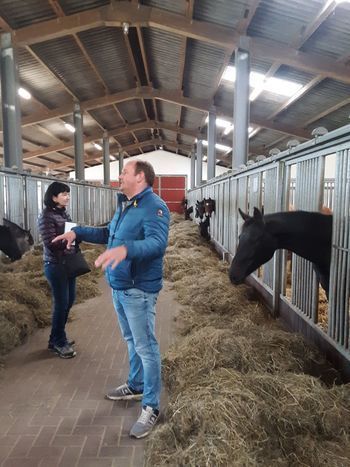
Hof Bruning

Yearlings
Goal 2) Farm Management.
We visited several family-owned and -operated breeding farms. One farm had been one of the original six surrounding a small local church in the 800s! Another had been in the same family, passed down from father to eldest son since 1420. This was the law, and it ensured that the original acreage was not subdivided. Old barns built in the 1700s and early 1800s were still in use and in good shape, the original massive beams held together with just wooden pegs. Modern stalls of metal were common, with internal partitions that folded to the wall for easy monthly cleaning. They bed with straw about knee-deep, then they simply add straw as needed every few days. This was the case for individual stalls as well as communal herd-type situations with maybe fifteen yearlings or two-year-olds in groups. After 30 days, the hinged partitions would be swung to the wall, and a front-end loader would be brought in to clean it all out. It would be aired out until dry, then bedded deeply again. Easy!
Hof Bruning was one family farm we visited. The grandfather had passed off daily operations to his son but was still in attendance and seemingly very much in the picture. The eldest grandson was lovingly underfoot, and presumably, the entire operation will be his one day. There, I was very happy to meet a States' Premium mare by the name of SPS Red Chili (by Rotspon). She produced, among others, the stallion Hampton (by His Highness) who is presently standing at Bridlewood Hanoverians in Kentucky and is owned by Louise Leatherdale. Hampton is a half-sibling to my His Highness mare, Hope TF. This- in a roundabout way- is pretty cool to me. OK, so they are only related "by marriage" so to speak. But still!
The Bruning family showed us around, then brought us into their house for some delicious butter cake and coffee, and there was a big painting of Hampton on the wall. They also gave us shots of some kind of Hanoverian-labeled alcohol. My kind of place!
Other small farms we visited were the Kreyenhagen family, the Rehkamp family, the Koneke family, the Mahler family, and the Luhrs family. Each was unique, and in hindsight, I can see why the Verband chose them for us to visit. The traditional family horse operation is still the backbone of the breeding industry in Germany, and it's obvious how the family pride runs deep. Colts are either gelded or if of sufficient quality they will be sent elsewhere for training to compete for the right to be licensed for breeding. These small farms think in terms of mare lines going back over 100 years! One farm had their three broodmares turned out fully braided for us, which we certainly didn't expect. Another farm was run by a young couple just starting out with land and buildings they purchased. It took them a year to get the abandoned barn up to snuff, and only then did they begin work on their own house.
Also, on the agenda were visits to some prominent and important stallion stations, including Landgestut Celle, the State Stud. Of the roughly 450 stallions authorized to breed in Germany, 100 are at Celle with the remainder in private hands. Here we got to meet old campaigners like Rotspon, Don Frederico, Londontime, Grey Top, and exciting young stallions like Despacito and Zakaria. A memorial garden and statue of Weltmeyer were prominently displayed. At Celle, like everywhere else we visited, they feed using large round bales and large square bales. Small squares were conspicuously absent, and I only saw them once the entire trip. At Celle, whole oats are delivered via an overhead vacuum line to each stall. A container above each stall is located under the vacuum line, and at the push of a button, all containers are emptied via gravity. Therefore, all horses are fed at the same time which cuts down on stomping feet and anxious horses. Whole oats seemed to be the most common feed at many of the farms.
A bit farther down the road was Adelheisdorf, which is Celle's stallion testing station. They were in the middle of a 50-day stallion test on three-year-old jumping stallions when we visited. Workers and riders were very busy preparing, riding, then cooling out the stallions. We got to see Shu Fu, Vidar, Viscount, and others in their stalls.
Andreas Helgestrand from Denmark recently opened a facility in Wellington, but I was ignorant of the fact that he, in partnership with Paul Schockemohle, also just opened one in Germany as well. Ulf and Eva Möller run the place in the summer, and then Ulf flies to Florida to run operations there in the winter. Ulf was the rider of Rotspon, among others, but now concentrates on starting young horses. Eva is still very active in the show ring, and we had the pleasure of watching as she schooled Danciero while Ulf talked. There were also some youthful-looking riders schooling Grand Prix moves on gorgeous horses, and when asked we were told they were the first and second place Young Riders in Europe last summer. We got to see Global Player, Furst Toto, Total Mclaren... the names just go on and on.
Hengstation Pape was another highlight. Here we got to see the stallions Despacito, V-Plus, Scolari, Macchiato, and Don Nobless as they brought them out of their stalls and presented them to us. Gorgeous, one and all!
Klosterhof Medingen. Originally an old monastery, many of the buildings are historic and cannot be altered. One building built in 1660 presently houses some of the workers and riders. A statue of Caprimond dominates the entrance. Famous stallions from Medingen include De Niro, Damaschino, Borsolino, Fidertanz (2021 Hanoverian Stallion of the Year), and Hohenstein.
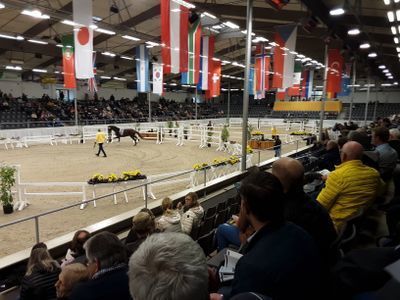
Lunging 2 year old's at Verden
Goal 3: Auction
Where to begin? In a nutshell, we have nothing in North America to compare to the young stallion licensing and auction we witnessed. Hanoverian two-year-old colts had been evaluated and culled over several weeks from 280 in number down to the 55 we saw our final two days. We saw them free jumping, the in-hand presentation "on the triangle,” then the lunging, and finally the presentation in front of about 2,000 knowledgeable spectators and bidders. Of those we saw, about half were licensed in conjunction with the auction, and all (with a few exceptions) were subsequently sold to the highest bidder at the Verband's famed Niedersachsenhalle indoor arena. To be licensed was the big goal: this allowed them to stay intact for at least another year, and then they can go to either a 14-day or 50-day Performance Test as 3-year-olds, after which a select few will be granted final permission to breed.
Earlier, I mentioned we visited family Rehkamp. They specialize in preparing stallions owned by others for the rigors of the licensing process. They only hire experienced men to handle the youngsters - when I asked why, they replied that these 2-year-olds are like early teenage humans; full of raging hormones and very unpredictable, and they will obey a forceful man better than a female. Other farms had women handling stallions, so this opinion was not universal. Of interest was the round pen used to introduce the lunging. It was like a large bowl with the center a good foot or two lower than the outside perimeter. I was told it was much easier on the legs since the horse has a banked surface to push against. The further out they got, the more severe the bank. On a blackboard near the barn entrance, the sire names of some of their recent charges were listed in chalk. It was a virtual who's who of famous stallions: Morricone, Secret, Vivaldi, Governor, Infantino, Danciano, Don Martillo, Dancier, Sandro Hit, Ibiza, and others.
The auction itself was quite the spectacle! The six colts judged Premium were the first to be auctioned. For 700,000 Euros, the Escamillo/De Niro colt was sold to Glock, who promptly named him Glock's Energy. It'll be interesting to follow him in future years. Fun fact: all these colts are officially named by their new owners. Until sold at auction, they are referred to only by their sire/damsire. The other Premium colts sold for 370K, 300K, 210K, 180K, and one was retained by his owners. On average, the licensed colts brought 125,346 Euros, and those unlicensed went for 38,364 Euros.
Keep in mind that these are just dressage-bred 2-year-olds! The Hanoverian jumper-breds are going through a similar process and auction as I type this report. Also, keep in mind that the Oldenburg GOV Verband has a similar process. Other studbooks, including Holsteiner, Westfalen, Trakhener, and others each have their own weeding-out and licensing processes. The numbers involved are mind-numbing.
It wasn't just an auction that Saturday night in the Verband Niedersachsenhalle. The 2021 Hanoverian Stallion of the Year award was presented to Fidertanz, sire of Foundation, and more than 50 other licensed stallions. Also, Dr. Ludwig Christmann had his retirement ceremony, and the Breeder of the Year and Handler of the Year were honored. All in all, the evening was very special.

Hosts: Maren, Juliana, and Bo
Conclusion
The overall experience was phenomenal! I would strongly encourage breeders to attend any of the Breeders' Courses offered in Europe. I can't speak to the others, but if they are even remotely as well run like this one, then they will be fantastic.
As an added and quite unexpected bonus, I got to meet over twenty like-minded strangers who by the end of the week became good friends. When you eat together, are bussed together, stay in the same hotel, and sit next to each other for eight days in an immersive environment, well- it's just icing on the cake to have new contacts all over the USA, and one in Canada to boot!
